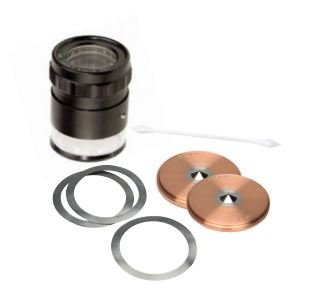Even experienced analysts can fail to recognize problems that hamper productivity in the ICP-MS workflow. So we’ve put together tips to help you recognize – and solve – problems in four key areas: sensitivity, accuracy, precision, and background.
Replace pump tubing regularly
Regular maintenance of the ICP-MS sample introduction system is required. This system is made up of three parts: the peristaltic pump tubing, nebulizer, and spray chamber.
Pump tubing can have a significant effect on the precision and stability of your analyses. For best performance, regularly inspect the tubing for roundness. Tubing that has flat spots must be replaced immediately. To maximize the life of the tubing, do not over tighten when clamping. Just tighten enough to allow a smooth and even flow of solution. Remember to detach the tubing from the holder after use, so that it can relax and recover. You should expect to replace tubing every one to two weeks under normal use (8 hours per day).
Accuracy, precision, and sensitivity are your top priorities
Accuracy, precision, and sensitivity are all critically dependent on the condition of the nebulizer. Partial blockage of the nebulizer can restrict aerosol formation, reducing sensitivity and degrading accuracy and precision. To confirm that the nebulizer is performing satisfactorily, regularly inspect the mist, or aerosol, formed in the transfer tube or spray chamber. If the mist is less dense, or shows excessive fluctuation, the nebulizer may be blocked.
Low flow nebulizers used for ICP-MS have minimal tolerance to dissolved solids and large particles. So, to prevent blockages, you should filter or centrifuge all samples before testing. If any undigested residue remains in the base of the sample container, set the probe height for the autosampler to avoid sampling from the base. In addition, to prevent contamination and possible ingress of dust (which can also result in blockages), always cover samples before use. Following these simple guidelines should reduce the chance of blockages. If nebulizer blockage does occur, you can quickly restore operation by back flushing the nebulizer. To learn how to remove a blockage, and the tools needed for efficient cleaning, watch the video. Take care when cleaning, as the nebulizer is fragile and could be damaged if handled incorrectly.
Maintenance of the spray chamber is much more straightforward compared with the nebulizer. But it also needs attention to ensure that buildup of sample residue does not degrade precision. Excessive droplet formation on the walls, poor precision, and memory effects or carryover between samples all indicate that maintenance is required. Watch the video.
Shine the light on torch maintenance
The components in the torch box should also be inspected regularly, particularly the torch, shield, and bonnet. Any cracking, degradation, or deformation can adversely impact plasma stability and may cause difficulty with plasma ignition. These damaged parts should be replaced immediately. Matrix deposition on the torch can be removed by soaking in an acid solution. However, to prevent damage to the torch, NEVER clean the torch in an ultrasonic bath. Watch the video to learn the right cleaning procedures. When you have removed the torch for cleaning, inspect the torch stand, connections, and alignment of the RF coil. After re-installing the torch, make sure that the plasma ignites, then re-optimize the plasma sampling depth. If the plasma fails to ignite, check that there are no loose connections or joints at the torch base or the transfer tube.
Extend the life of your ICP-MS consumables
Dirty, blocked, or damaged interface cones can adversely affect the sensitivity, accuracy, and background of your analysis. To ensure good condition of the orifice, on the sampler and skimmer cones, complete regular inspections.
Check the vacuum level in the interface region for gradual increases – an indicator that cone maintenance is required. Take care when removing and handling the cones, especially the smaller skimmer cone, as the tip is delicate. Incorrect handling can irreversibly damage the cone, especially if it comes into contact with any other surface.
Inspect the orifice of the cone with a magnifier that has an illuminated field of view and 10x magnification if possible. Replace the cone if the orifice is enlarged or out of shape, or if you see any localized discoloration, which may indicate overheating. Excessive cleaning can also reduce the life of the cone, so always follow our step-by-step cleaning recommendations. Watch the video to learn the right cleaning procedures. Thoroughly dry the cone before re-installing it.
Another key component in the interface region is the extraction lenses, located behind, and attached to, the skimmer base. Cleaning the extraction lens is only required after you have finished troubleshooting the sample introduction system and interface cones. To learn more about cleaning the extraction lenses, watch the video.
Don’t overlook simple preventive maintenance procedures
Most ICP-MS instrument failures occur in the sample introduction area. Improper maintenance of these components can result in poor quality data. Establishing regular preventative maintenance procedures can help prevent problems before they occur and extend the life of your consumables.
You can find more information on the spectroscopy workflow supplies selection here
Keywords: Spectroscopy; ICP-MS; spectroscopy workflow; atomic spectroscopy; lab productivity; interface cone; nebulizer

